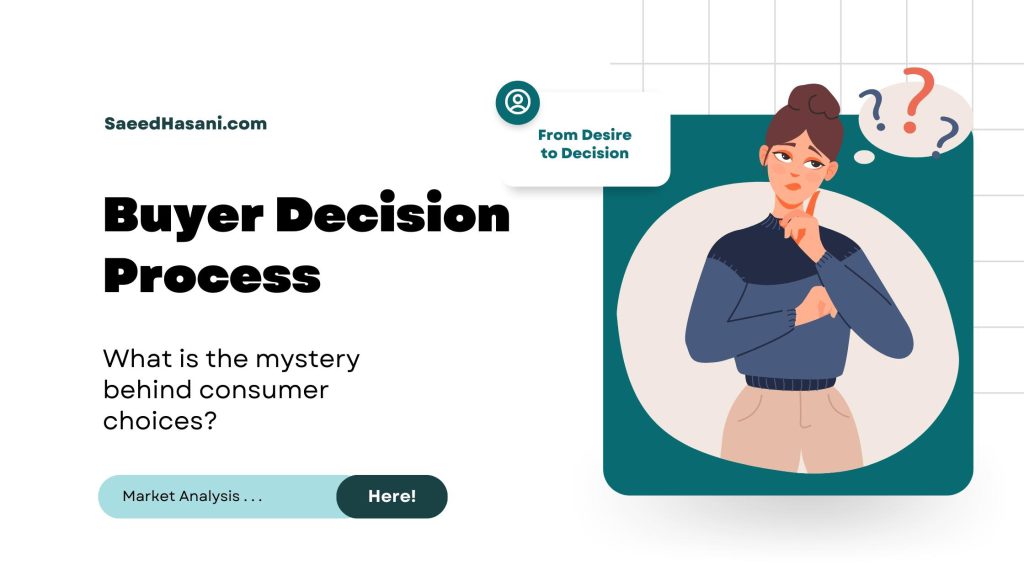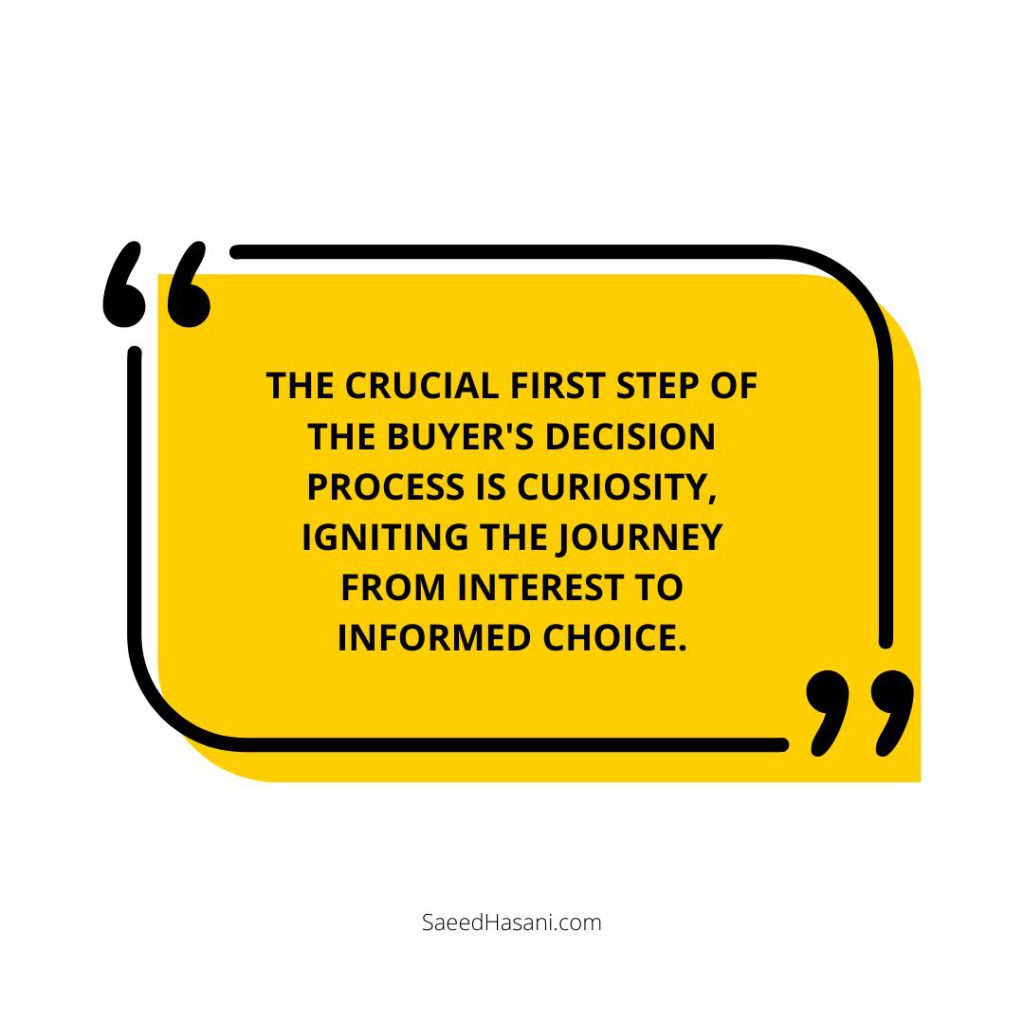Buyer decision process | From Desire to Decision: The Psychology Behind Consumer Choices

In this article, you will learn about the buyer’s decision-making process. We will answer various questions about the buyer’s decision-making process. If you enjoyed reading this article, please share it with your friends so they can learn more about the buyer’s decision-making process.
What is the consumer decision-making process?
The buyer decision process, also known as the consumer decision-making process, unfolds through a sequence of steps as individuals contemplate, evaluate, and ultimately arrive at a choice regarding a purchase or consumption-related matter. This systematic process empowers consumers to make well-informed decisions by methodically assessing their requirements, inclinations, and the array of options available. This decision-making journey typically encompasses several vital stages:
1. Recognition of Need: This initial stage marks when consumers acknowledge a requirement or desire. Internal factors like hunger or boredom and external factors such as advertising or recommendations can trigger it.
2. Quest for Information: Following recognizing a need, individuals embark on a quest to gather information about potential solutions. This pursuit involves tapping into internal knowledge and seeking external insights from friends, family, online reviews, advertisements, and expert opinions.
3. Comparing Alternatives: At this phase, consumers meticulously evaluate the range of options at their disposal to fulfill their needs or desire. They meticulously scrutinize the attributes and features of different products or services, juxtaposing them based on quality, pricing, brand reputation, and benefits.
4. Decision to Purchase: Consumers determine the specific product or service they intend to buy after thoroughly assessing alternatives. An amalgamation of personal preferences, perceived value, budgetary considerations, and external influences such as sales promotions or discounts shapes this determination.
5. Completion of Purchase: This stage is the culmination, where consumers execute the purchase. That could occur online or in physical stores, contingent upon the individual’s preferences and the nature of the product.
6. Reflecting on Purchase: Consumers reflect on whether the product or service meets their expectations after the purchase. Success in this regard leads to contentment, whereas any disparity might trigger discontent. This post-purchase assessment also holds sway over future buying decisions and the consumer’s perception of the brand.
7. Post-Purchase Behavior: Anchored in the degree of satisfaction or dissatisfaction, consumers may exhibit diverse behaviors. Contented customers could morph into repeat purchasers and enthusiastic brand advocates, while those unsatisfied might contemplate returning the item, pursuing refunds, or conveying negative feedback.
Recognizing that the consumer decision-making process isn’t always a linear progression is imperative. Individuals might bypass or revisit certain stages, governed by their familiarity with the product, the urgency of their requirement, the intricacy of the decision, and other variables. Moreover, the emotional and psychological facets can influence consumer choices at each juncture of this journey.
What is the first step of the buyer decision process?
Have you ever wondered what goes on in a consumer’s mind before purchasing? The buyer decision process often called the consumer decision-making process, is like a roadmap that guides individuals through selecting a product or service. At the heart of this process lies the initial “Recognition of Need” or “Problem Recognition.”
Imagine this process as a series of steps shoppers take before sealing the deal. The first stride, the Recognition of Need, marks the commencement of this voyage. It’s that moment when consumers identify a gap between their current situation and their desired state. This void may emerge due to various factors, such as a change in circumstances, a longing for something better, or an unmet necessity.
For instance, picture someone realizing they require a new smartphone when their existing one becomes outdated or starts acting up. This awakening is the catalyst for the rest of the decision-making expedition. As the shopper moves forward, they begin gathering information, weighing their options, ultimately making a choice, and concluding with the ultimate action: making the purchase.
It’s essential to remember that this buyer decision process isn’t a one-size-fits-all model. The intricacy of the purchase and an individual’s unique preferences and experiences can sway the steps and their sequence. By delving into this journey, businesses can better comprehend their customers, tailor their strategies, and meet the diverse needs that steer decision-making.

Stages of the buying process
The buyer decision process, often called the consumer decision-making process, encompasses a sequence of phases individuals undergo when reaching a purchasing verdict. These stages provide valuable insights into consumer choices’ inner workings and the many factors that shape their decisions. Here’s a breakdown of these stages:
Recognition of Need: Consumers embark on the journey by acknowledging a disparity between their current and desired circumstances. This realization may stem from evolving situations, unmet needs, or a yearning for enhancement.
Information Quest: Once the need is pinpointed, consumers set out to gather information about potential solutions. Many sources include personal experiences, word-of-mouth from peers and family, advertisements, online reviews, and expert insights.
Assessment of Alternatives: Progressing to the next phase, consumers meticulously evaluate the array of choices available. They meticulously weigh attributes like price, features, quality, and the reputation of brands. By scrutinizing the advantages and disadvantages of each alternative, they pave the way for an educated decision.
Decision to Purchase: With insights from the previous stage, consumers decide which product or service to acquire. Cost, discounts, availability, and personal inclinations may influence this verdict.
Completion of Purchase: The actual acquisition unfolds in this stage, materializing through online or in-store purchases. The mode of purchase is tailored to the consumer’s preferences and convenience.
Post-Purchase Behavior: Following the transaction, consumers assess whether their expectations were met. Satisfaction reinforces their choice, while disappointment could trigger a reevaluation that influences their future buying decisions.
Reflective Evaluation Post-Purchase: The final stage entails consumers reflecting on their purchase experience. Positive encounters often lead to loyalty and repeated transactions. Conversely, negative episodes might culminate in returns, grievances, or a shift to competing brands.
It’s essential to recognize that these stages within the buyer decision process don’t always follow a strict linear order and can be influenced by the complexity of the purchase and the unique decision-making style of each individual. Emotional triggers, societal influences, and external circumstances can also impact the buyer’s decision process. By delving into these stages, businesses can tailor their marketing strategies to meet consumer needs at every step, ultimately enhancing customer contentment along the entire buyer decision process journey.
What is the evaluation of alternatives in marketing?
The term “evaluation of alternatives” holds great significance in marketing as it signifies a critical juncture within the buyer decision process. At this stage, potential buyers delve into comparing and assessing diverse products, services, or brands before making their final purchase decision. This phase unfolds after consumers have recognized a need, gathered information about available choices, and are now in the active process of weighing the merits and drawbacks of each option.
In the course of this evaluation of alternatives, consumers factor in a multitude of considerations that hold personal importance to them, including:
Attributes and Features: Consumers meticulously compare each available alternative’s specific attributes and features. They aim to discern which option aligns most seamlessly with their needs and preferences. That might encompass size, color, performance, functionality, and more.
Price: Undoubtedly, price plays a pivotal role. Consumers deliberate whether the benefits offered by a product or service stand as a valid justification for its cost and whether it harmonizes with their budget.
Quality: Consumers embark on an evaluation of perceived quality. That involves considering factors like durability, reliability, and reputation. They intend to ensure that their decision culminates in a reasonable investment.
Brand Reputation: The perception of a brand’s reputation holds considerable sway. Consumers often lean toward brands they trust or those that garnered positive experiences in their past interactions.
Social and Cultural Factors: Cultural and social influences impact consumer choices. Aligning with personal values, beliefs, or lifestyles might steer consumers toward particular products.
Reviews and Recommendations: The opinions of fellow customers are often sought after. Positive reviews can tip the scale in favor of a specific choice, whereas negative feedback could instigate a reconsideration.
Personal Preferences: Individual preferences, from aesthetic inclinations to personal habits, can significantly mold decision-making.
Perceived Benefits: The array of benefits offered by each alternative undergoes scrutiny. These benefits could span functionality, emotional appeal, or psychological resonance.
Risk Assessment: Delving into risk assessment, consumers factor in potential downsides tied to each option. That could involve contemplating the likelihood of dissatisfaction or the possibility of encountering post-purchase issues.
Evaluating alternatives is pivotal as it directly shapes the ultimate purchase decision. Marketers endeavor to provide lucid and compelling information about their offerings during this stage. The objective is to establish a favorable impression within the minds of consumers. By gaining a profound comprehension of the factors that steer consumer evaluations and inclinations, businesses can tailor their marketing endeavors to address these considerations effectively. This proactive approach significantly enhances the prospects of transforming potential customers into steadfast buyers.
Information search in consumer behavior
In consumer behavior, the “information search” phase is a pivotal milestone within the broader buyer decision process. At this juncture, individuals proactively seek to acquire relevant information about products, services, or brands. This pursuit is fueled by the intention to make an educated purchasing choice. Notably, the information search step unfolds after consumers identify a specific need or challenge but before delving into evaluating different alternatives.
During the information search stage, consumers engage in various activities to assemble the insights they seek. These activities encompass:
Internal Search: Consumers tap into their personal experiences and knowledge repository to recollect products or brands that align with their requirements. That involves drawing from past encounters, familiarity with specific brands, and recollections of previous purchases.
External Search: Consumers explore external sources beyond their encounters for a more comprehensive understanding. That could entail soliciting advice from friends, family, and colleagues, immersing themselves in online reviews and testimonials, consulting expert perspectives, and utilizing comparison platforms.
Commercial Sources: Consumers delve into promotional materials provided by companies offering the products or services. These encompass advertisements, brochures, catalogs, and websites that spotlight the offerings’ merits, features, and advantages.
Public Sources: Impartial viewpoints emerge from public sources such as consumer reports, product evaluations, and independent reviews. These sources furnish unbiased insights into the pros and cons of various choices, exerting a notable influence on consumer perceptions.
Personal Sources: Recommendations and viewpoints from the consumer’s circle play a role. That might entail seeking counsel from friends, family members, or acquaintances with pertinent experience.
Experiential Sources: Certain consumers engage with products physically before finalizing a decision. That could involve in-store visits, product demonstrations, or trial sessions to gain direct hands-on experience.
Digital and Online Resources: The advent of the internet has reshaped the information search landscape. Consumers leverage search engines, social media platforms, online forums, and review websites to access diverse insights from diverse sources.
The significance of the information search stage is underscored by its capacity to equip consumers with the knowledge needed to make well-informed decisions in line with their needs, preferences, and the array of options available. Marketers recognize the pivotal role of this stage and endeavor to furnish pertinent, easily accessible information to prospective customers. By aligning their strategies with the sources of information consumers rely upon and catering to these avenues, businesses stand to bolster their ability to captivate and gratify consumers during this critical phase.

Need recognition marketing
Within the dynamic marketing realm, the concept of “need recognition” is a fundamental stepping stone that lays the groundwork for consumer decision-making. This pivotal moment arises when individuals detect a gap between their current situation and their envisioned outcome. Evolving circumstances, unmet demands, or a drive for improvement often prompt this gap.
For marketers, delving into the nuances of need recognition within the buyer decision process proves indispensable. This initial spark of awareness offers a strategic window to align products, services, and campaigns with the desires of consumers.
Consider a scenario where an individual identifies the need for a cutting-edge smartphone due to their outdated device or missing features. This awakening serves as the catalyst that propels them into the subsequent phases of the consumer decision process.
Enterprises can harness this insight in various impactful ways:
Product Innovation: Spotting developing needs within the buyer decision process can guide the development of novel products or the enhancement of existing ones. By addressing these gaps, businesses position themselves as problem solvers, capturing the attention of consumers who seek enhancements.
Alignment of Messaging: Crafting marketing messages that strike a chord with the pain points or aspirations experienced during need recognition can forge an emotional connection. These messages underscore how a product or service can bridge the gap and fulfill those aspirations.
Precision in Targeted Campaigns: Tailoring marketing campaigns to harmonize with distinct needs empowers businesses to engage individuals actively seeking solutions. This tailored approach heightens campaign efficacy and return on investment.
Educational Content: Offering informative content that guides consumers through their need recognition phase establishes a brand as a reputable source. This tactic fosters trust and positions the brand as a valuable companion on the consumer’s journey.
Personalization through Data: By leveraging data to comprehend individual consumer behaviors and preferences, businesses can furnish personalized recommendations and solutions as soon as a need is acknowledged.
Acknowledging the pivotal role of need recognition within the marketing landscape is akin to uncovering a strategic treasure trove. It allows businesses to forge connections with consumers at a fundamental level, addressing their needs, dreams, and challenges profoundly. By harmonizing products, messaging, and campaigns with this initial flash of realization, marketers can adeptly shepherd consumers through their decision-making expedition, establishing enduring relationships between brands and consumers.
Conclusion
We tried to explain the buyer decision process in this article. One of the questions about the buyer decision process is what is the consumer decision-making process?
For this reason, we answered this question and stated that factors such as Recognition of Need, Comparing Alternatives, and Post-Purchase Behavior are effective in the buyer decision process.
We also provided helpful information about the stages of the buying process. We hope that reading this article was helpful for you.







Responses